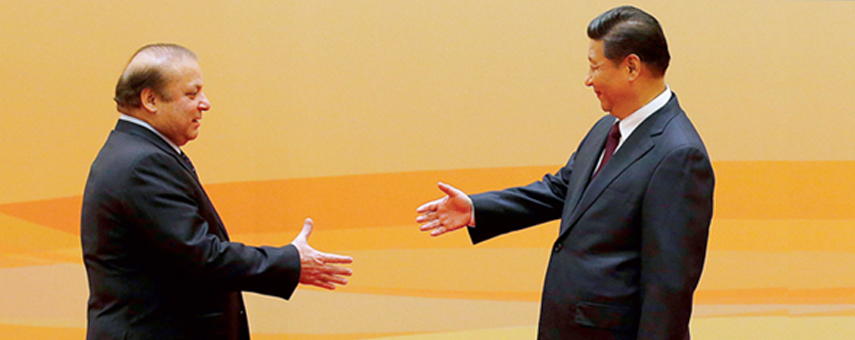A project of the scale of the CPEC perhaps comes once in the lifetime of nations, hence it is imperative to delve deeper into its advantages.
There is a lot of bickering going on amongst Pakistani politicians from various provinces regarding the China Pakistan Economic Corridor (CPEC). Some claim that it is going to benefit only the ruling party, others allege that only Punjab will gain from it while the other provinces will be left in the lurch. Others find fault with the route and surmise that it has been deliberately altered to promote the interests of Punjab. A few relegate the importance of the CPEC, considering it to be just a freeway. The fault perhaps lies in the way that the ruling was issued in Islamabad, without explaining the importance and magnitude of the project or elucidating the advantages that Pakistan will accrue from this all encompassing plan. Normally, politicians love to crow on about even minor achievements from the rooftops. A project on the scale of the CPEC perhaps comes once in the lifetime of nations, hence it is imperative to delve deeper into its advantages. For a country like Pakistan, which faces enormous challenges in terms of both law and order and a dwindling economy, the CPEC offers a panacea to most of its problems and will uplift the quality of life of its citizens.
The project embraces the construction of a cross-border optical fibre cable system between China and Pakistan, textile garment industrial park projects, numerous ventures in the energy sector yielding power from various sources comprising hydel, coal, wind power, solar and nuclear. It also entails the development of coal mining projects, the construction of dams, the installation of nuclear reactors and creating networks of roads, railway lines and oil/gas pipelines. Agreements have been made to construct a new international airport, Eastbay expressway, fully equipped hospital, a technical and vocational training institute, water supply and distribution, infrastructure for free zone and export processing zones, port related industries, refineries and marine works. The infrastructure projects planned comprise of the Karakorum Highway Phase II (Raikot-Islamabad), Karachi-Lahore Motorway (Multan-Sukkur section), expansion and reconstruction of existing the mail railway line from Peshawar to Karachi, the construction of a Havelian dry port, orange line project in Lahore and a cross-border optical fibre cable system project.
Some of the significant energy projects being installed will yield around 10,400 megawatts of electricity. Those ventures include the Port Qasim Electric Power Company, producing 1,320 megawatts, Engro Thar coal-fired power plant, producing 660 megawatts, Sindh Sino resources power plant of Thar Coal (Block-1), producing 1,320 megawatts, Gwadar coal power project, producing 300 megawatts, Rahimyar Khan coal power, producing 1,320 megawatts, Muzaffargarh coal power, producing 1,320 megawatts, Sahiwal power plant, producing 1,320 megawatts, Suki Kinari power project, producing 870 megawatts, Karot Hydro power station, producing 720 megawatts, UEP wind power project, producing 100 megawatts, Sunec wind power project, producing 50 megawatts, Sachal wind power project, producing 50 megawatts, Dawood wind power project, producing 50 megawatts and Quaid-e-Azam solar, producing 900 megawatts.
In order to make the CPEC operational, the Chinese government has set up a special economic zone in the historical city of Kashgar, the border city between China and Pakistan. The Chinese government plans to complete this economic zone by the year 2020, for which duration Pakistani industrialists have been offered a tax-free zone and other concessions. This economic zone will prove to be the key to trade between China, Pakistan, India, Afghanistan and eight other central Asian states bordering both China and Pakistan. A railroad network is being constructed to ensure swift trade via this link. Some Pakistani politicians are becoming impatient regarding the construction of the road network plying through their constituencies. They fail to comprehend that the communication infrastructure will benefit all of Pakistan. Linking the existing infrastructure with the detailed planned project has been made a priority. Thus the region will be linked through modern means of communication including rail and road links providing trade and economic opportunities to not only China and Pakistan but the entire South Asian region through Gwadar and Karachi ports.
Both sides have pushed forward the implementation of early harvest projects as well as the preparation of the projects of the long-term plan in all sectors, have agreed to finalise the long-term plan of the corridor by July, 2015 and to speed up the process of its drafting. The early harvest projects of the CPEC, which include the laying of rail and road networks besides several long and short-term energy projects will be completed within a span of two to three years. The CPEC route starts from Kashgar, the traditional business centre in China’s Xinjiang province, which connects China to South Asian and central Asian states. The CPEC then enters Pakistan through the 1,300 kilometre long Karakoram Highway (KKH) and runs throughout Pakistan, finally reaching Gwadar Port in the South of Balochistan. It is clear that the CPEC will not only benefit the whole of Pakistan but will also contribute to regional peace, stability and prosperity if only we are patient.
By S M Hali Published in The Daily Times, April 20, 2015.

